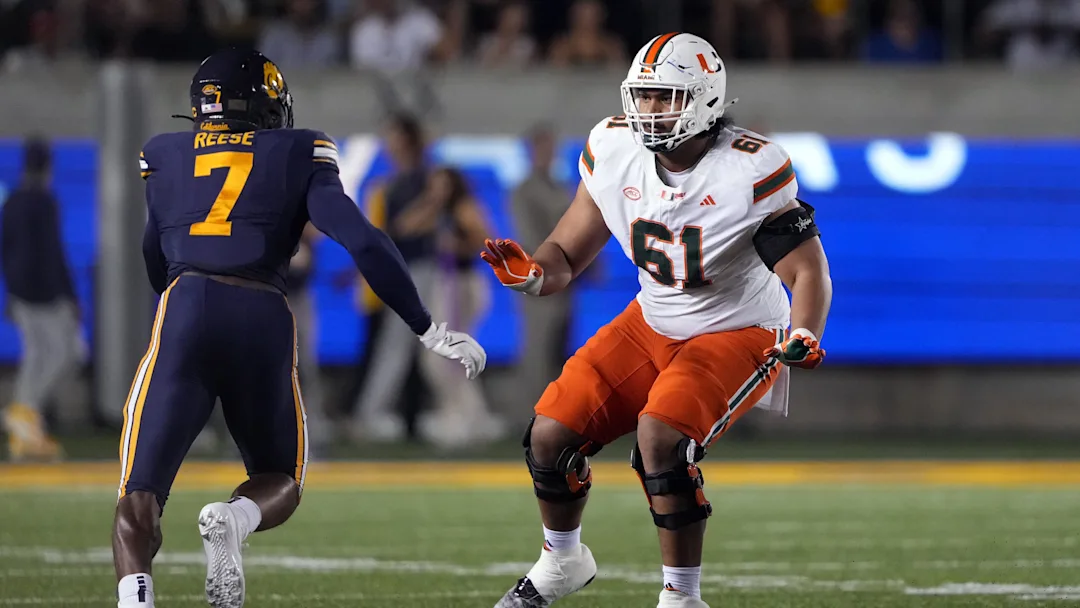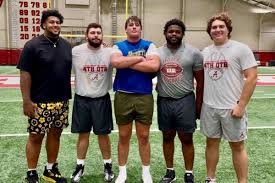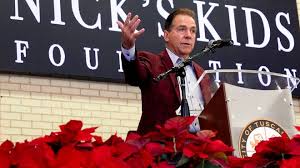As the spring competition heats up in Coral Gables, the Miami Hurricanes are making it clear that one of their top priorities heading into the 2025 season is building depth along the offensive line. With a new season approaching and expectations steadily rising under head coach Mario Cristobal, the Hurricanes understand that the foundation for success in the Atlantic Coast Conference begins in the trenches. The importance of establishing a solid offensive line goes beyond mere protection and run blocking—it is a culture-defining element, a tone-setting unit that often dictates the ceiling for any offense. For Miami, the search for reliability, flexibility, and dominance along the offensive line is well underway as spring practices roll forward.
Coach Cristobal, a former offensive lineman himself, has always placed a premium on line play. It’s a philosophy that has carried over from his time at Oregon to his current tenure at Miami. From the very first day he took over the Hurricanes program, Cristobal made it clear that the physicality and identity of the team would start with the big men up front. That commitment is now on full display, as the Hurricanes not only develop returning linemen but actively recruit and evaluate potential contributors from the high school ranks and the transfer portal.
The Hurricanes’ offensive line room is a mix of seasoned veterans, promising underclassmen, and newcomers who bring fresh energy and competition. With a long and grueling season on the horizon, the ability to rotate and rely on a second or even third string without a dramatic drop in performance is vital. Injuries are inevitable in a physically demanding sport like football, and for Miami to remain competitive throughout the fall, the staff is determined to have a deep, battle-tested group ready to go.
One of the cornerstones of this push for depth is development. The Hurricanes’ coaching staff, led by offensive line coach Alex Mirabal, is focusing heavily on technical refinement during the spring. Footwork, hand placement, pad level, and communication are being drilled constantly. Mirabal, who shares Cristobal’s passion for trench warfare, is known for his meticulous teaching style and fiery coaching presence. He demands perfection but also provides the instruction necessary for players to reach their full potential. During the spring, practices have been designed to simulate game-like situations, forcing linemen to think quickly and react under pressure—exactly the kind of environment where true depth is tested and revealed.
Among the returning veterans, players like Anez Cooper and Jalen Rivers are being counted on not just for their physical tools but for their leadership and consistency. Rivers, in particular, has been a steady force on the line for the past couple of seasons and is taking on an even greater leadership role this spring. Cooper, known for his power and raw strength, is being groomed into a more complete player, with an emphasis on mobility and discipline in pass protection.
Behind them are several second-year players who flashed potential in limited action last year and are now being given expanded roles during spring camp. These include linemen like Samson Okunlola and Tommy Kinsler, both of whom have the physical attributes to develop into long-term starters. Okunlola, a highly regarded recruit, has shown flashes of dominance in one-on-one drills and is working on improving his consistency and conditioning. Kinsler has impressed with his agility for a player of his size and is making a case for increased playing time.
The spring also brings opportunities for early enrollees and younger linemen to stake their claim. Players like Juan Minaya and Deryc Plazz are experiencing their first taste of college football and are being thrown into the fire early. These reps are invaluable—not only do they accelerate development, but they help the coaching staff assess who might be ready to contribute this season and who needs more time in the weight room and film study. While it’s rare for true freshmen to break into the starting five, strong spring showings can put them in the rotation by fall or solidify their role as backups capable of stepping in when needed.
In addition to internal development, Miami continues to explore options in the transfer portal. The staff understands that experience and versatility are gold in today’s college football landscape. They are actively evaluating linemen who have started multiple games at the Power Five level and can play multiple positions. The goal is to not only bring in talent but to find players who fit the scheme and culture being cultivated in the program. The portal offers a unique opportunity to plug gaps quickly and Miami is making sure they leave no stone unturned in their pursuit of quality depth.
Competition is at the heart of Miami’s spring practices. Every rep is monitored, graded, and evaluated. There is no coasting, no guaranteed playing time. Even returning starters are being pushed to defend their positions, and this competitive environment is exactly what the staff wants. Cristobal believes that true depth isn’t just about having bodies—it’s about having players capable of pushing each other to new heights. That iron-sharpens-iron mentality has been a core part of the Hurricanes’ spring camp.
Another key factor in the Hurricanes’ pursuit of offensive line depth is their evolving offensive identity. With a new offensive coordinator looking to implement a balanced, fast-paced attack, the linemen are being asked to adapt to a system that emphasizes versatility. Zone blocking, pulling, screen setups, and pass sets are all part of the daily routine. The linemen must be athletic enough to get to the second level but also strong enough to anchor against elite defensive tackles. This dual demand means the depth chart must feature a variety of body types and skill sets.
Miami’s spring scrimmages have offered a glimpse into how the depth is shaping up. While the first unit has looked solid, the second and third groups are showing signs of cohesion and development. Mistakes are still being made—missed assignments, false starts, communication breakdowns—but the effort and physicality are evident. Coaches are quick to correct errors and just as quick to praise effort and improvement. The spring is a time for growth, and the Hurricanes are using every moment to build something lasting.
Off the field, the emphasis on nutrition, strength training, and mental preparation is also contributing to the depth-building efforts. Players are working with nutritionists to add good weight, trim excess, and optimize performance. Strength coaches are targeting specific muscle groups to help players withstand the rigors of a full season. Meanwhile, film study is helping younger players understand defensive tendencies and scheme responsibilities. These off-field efforts are just as important as what happens during practice and serve to accelerate the development curve for less experienced players.
As the spring progresses, one of the main takeaways is that Miami is no longer content with just five or six competent linemen. The new standard is to have eight to ten ready contributors, each of whom can step in without a major drop-off. This isn’t just a contingency plan—it’s a competitive advantage. Being able to rotate fresh linemen or adjust to in-game injuries without sacrificing efficiency can be the difference between winning and losing tight ACC matchups.
The push for offensive line depth this spring is about more than just preparing for 2025—it’s about building a sustainable model for future success. Recruiting elite high school linemen, developing them through intensive coaching and conditioning, supplementing with experienced transfers, and fostering internal competition all combine into a formula that Miami hopes will pay dividends not just this season, but for years to come.
As fans look ahead to the fall, there will be plenty of attention paid to the quarterback battle, the wide receiver depth chart, or the development of the defense. But inside the program, the coaches know that the success of all those units starts with the offensive line. It’s the quiet engine that powers everything. And in Coral Gables, that engine is being built piece by piece this spring—with toughness, detail, and depth as the driving principles. The Hurricanes know where games are won and lost, and this spring, they are working to ensure they win those battles up front.



